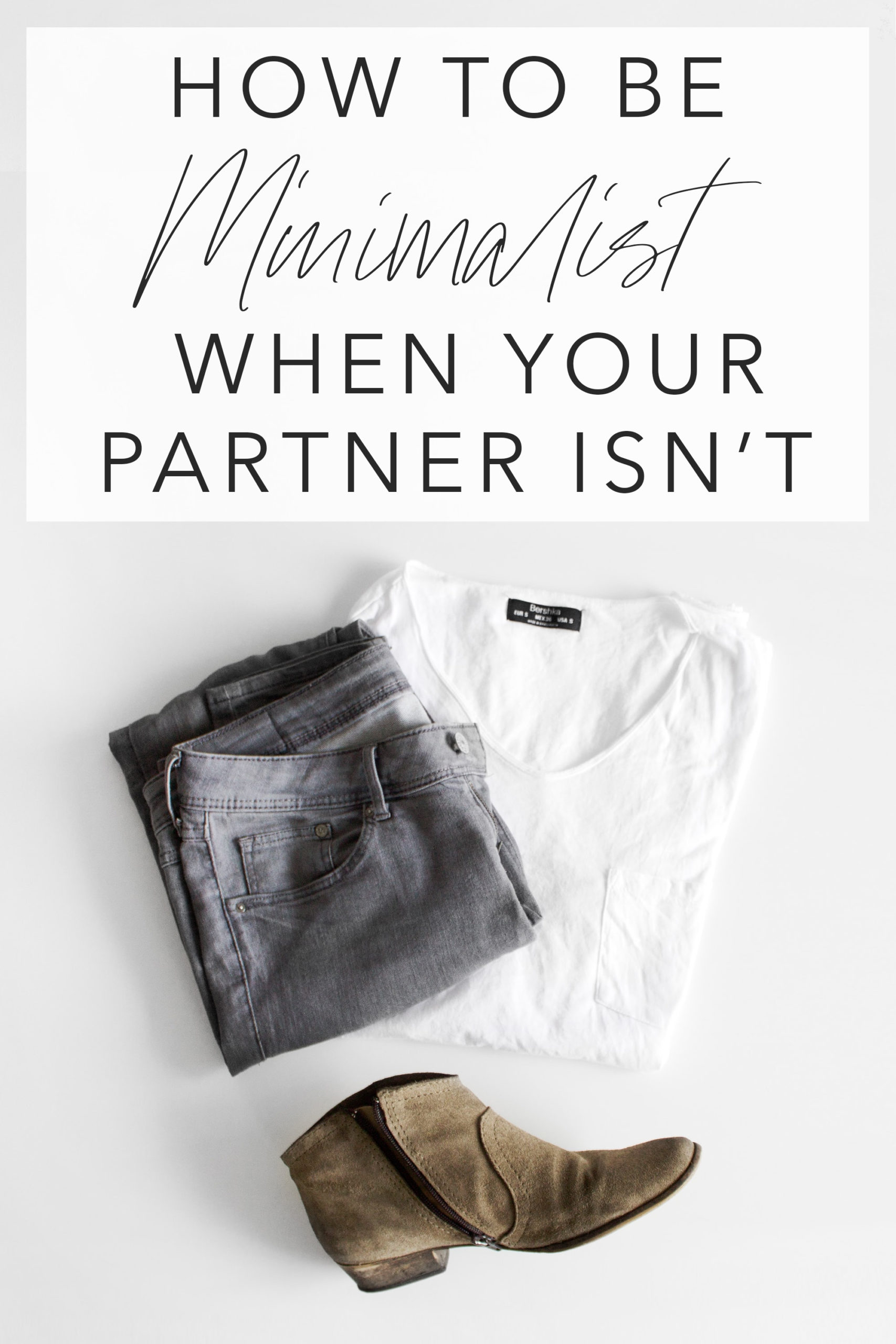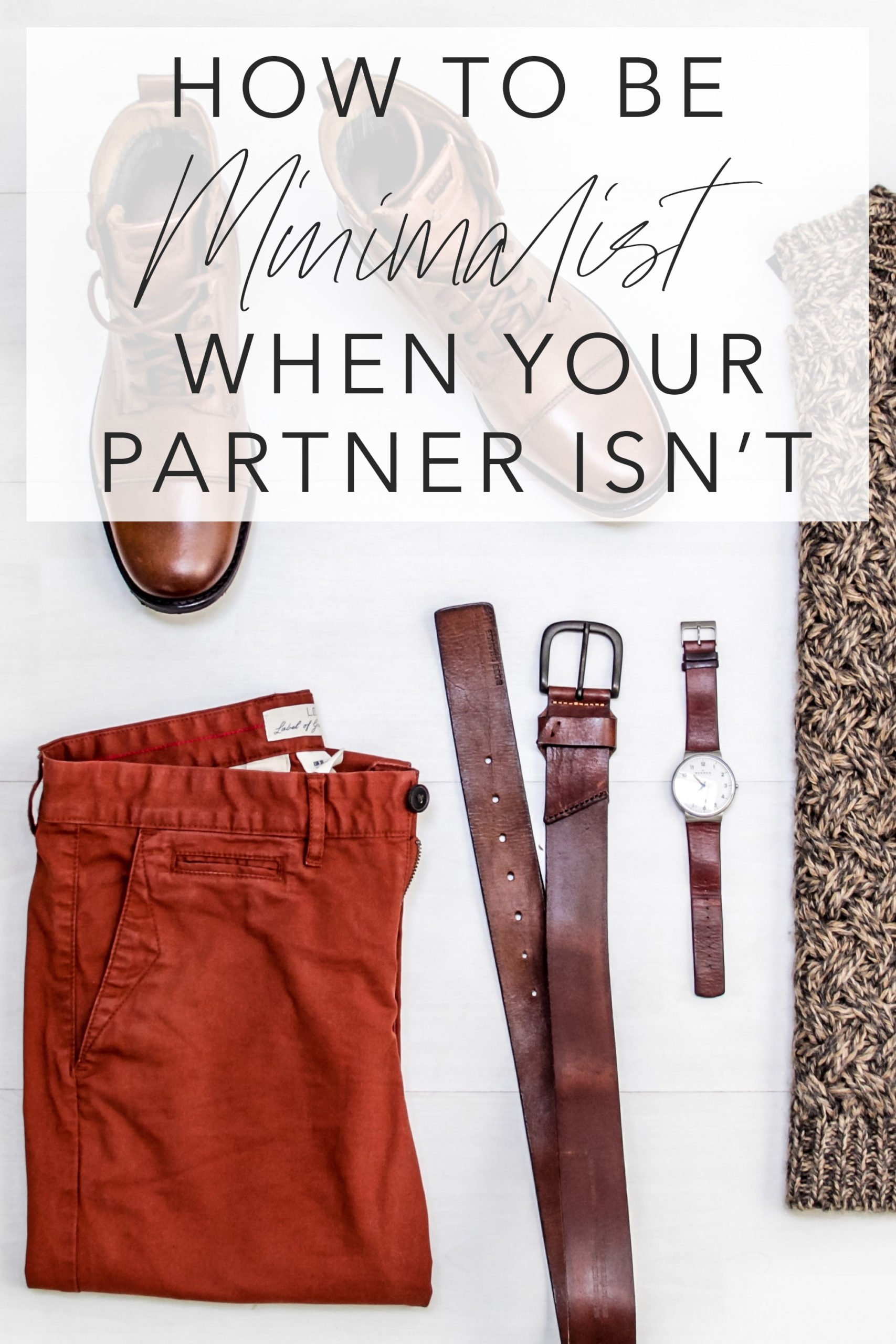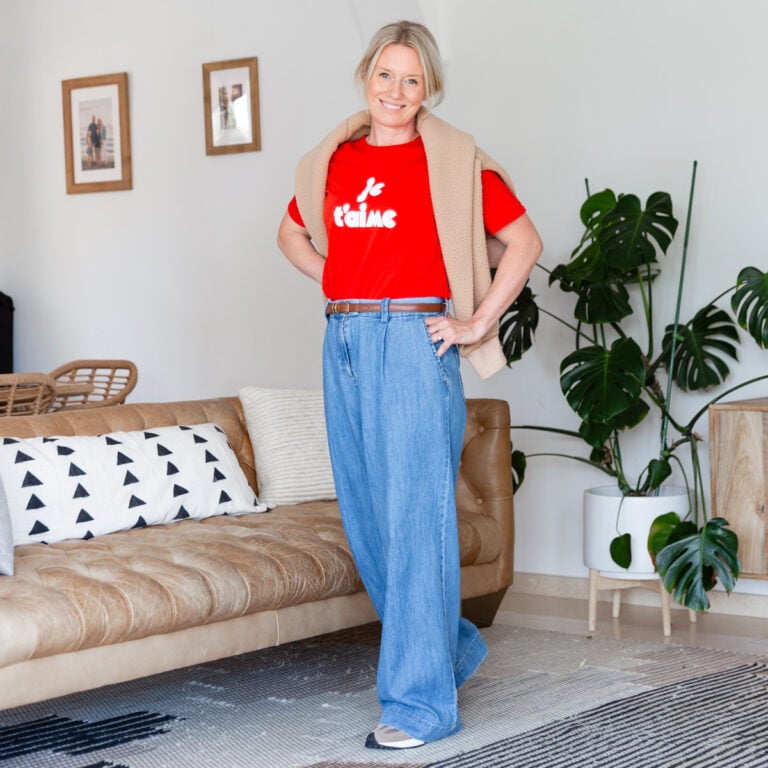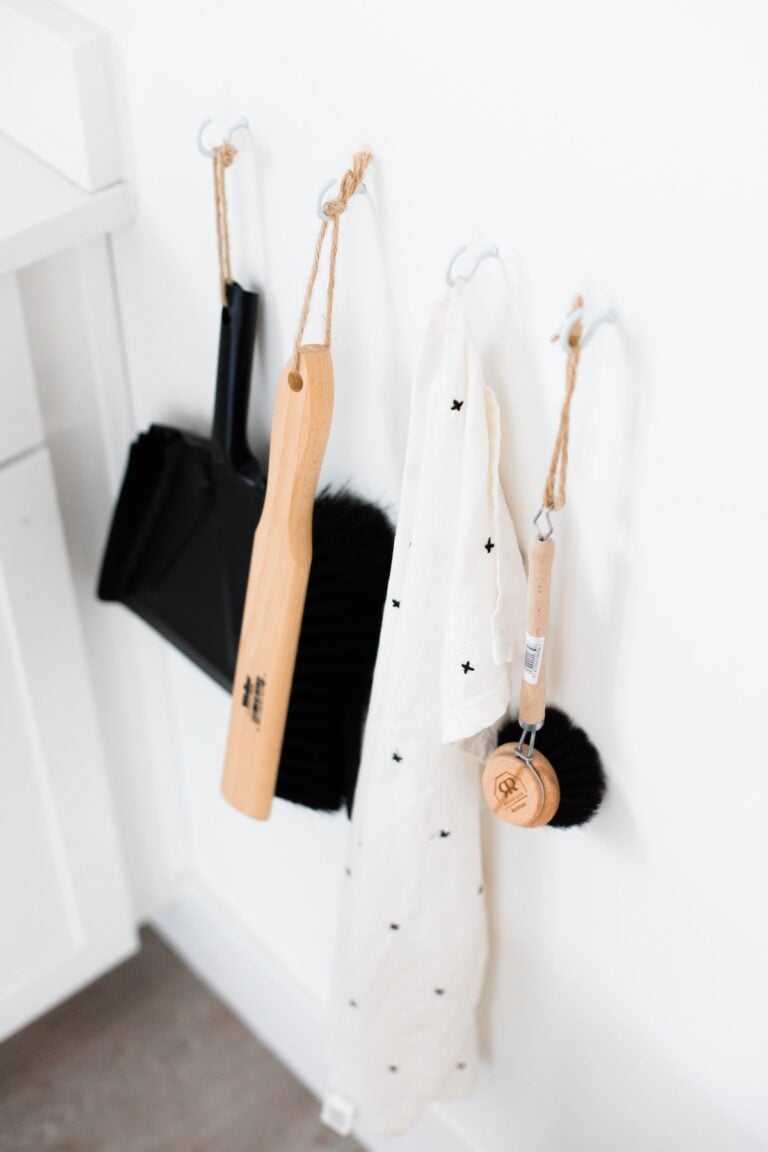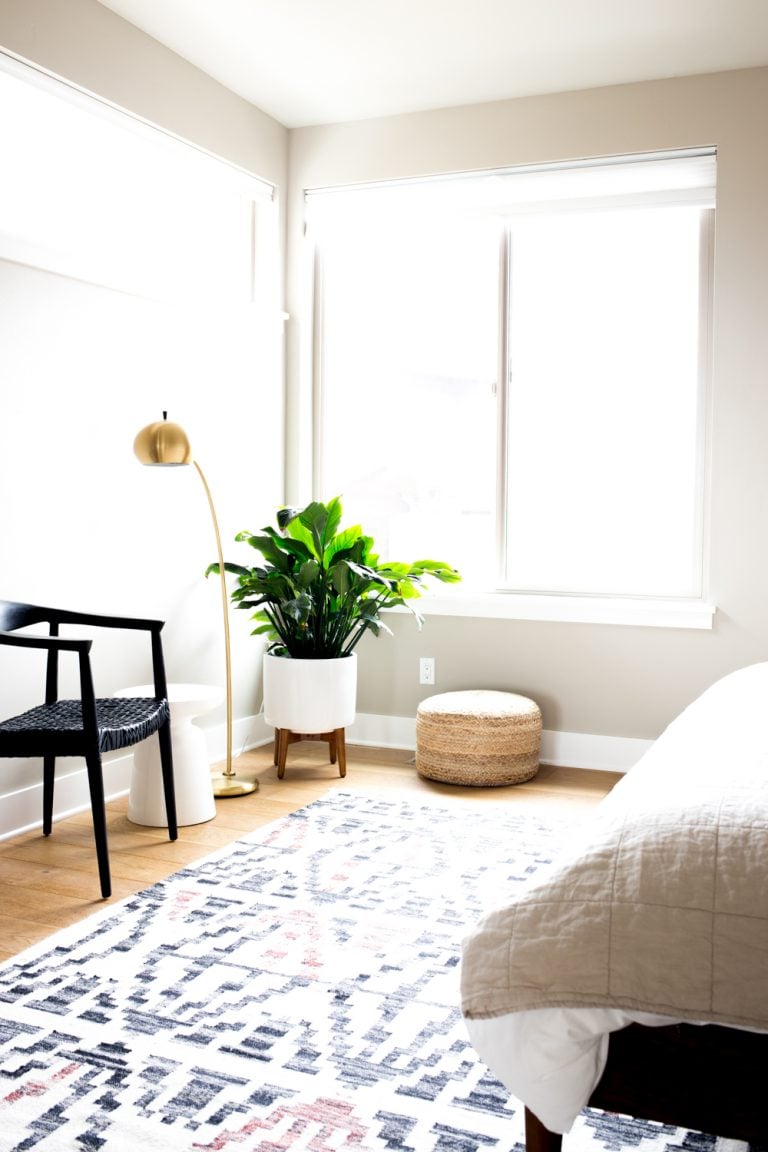How to Be Minimalist When Your Partner Isn’t
Are you looking to simplify and live more minimalist, but getting resistance from your significant other? Here are 7 things you can do (and what you can declutter!) to be minimalist even when your partner or spouse isn’t on-board.
My husband is a simple but sentimental guy. He’s the kind that hangs onto ticket stubs, seashells from beach vacations, handwritten notes, and boxes of brand new shoes.
Minimalist or not, we all have our things. I hoard sweaters. My husband collects shoes — a side effect of having worked for two footwear companies in his 20s and early 30s. When we first met I noticed he had dozens of boxes of new shoes stacked to his closet ceiling. Brand new, never worn shoes. Some in his size, some not. “They’re a special edition,” he told me. “And one day they’re gonna be worth a lot of money on eBay.”
Now, this was years before I discovered minimalism, and still the tower of shoes overwhelmed me. The thing is, when you’re dating someone you really like and you both still have your own separate lives and living spaces, your beloved’s clutter is easy to overlook.
Move in together and, well, it can quickly become a point of contention.
Tackling the topic of clutter with your partner is hard… especially when you look at clutter through very different lenses.
The truth is, the boxes of shoes stacked to the ceiling or massive pile of paperwork sitting on the desk that gives you anxiety may have zero effect on your partner, and may never will.
So how do you live like a minimalist when your partner isn’t? Should you try to change them, or declutter their things behind their back? Here are some things I’ve learned from my journey that might help you live your best minimalist life, even if your partner isn’t on board.
1. Start with your own stuff.
Do not, I repeat… Do not pressure your partner to declutter or get rid of a bunch of their stuff behind their back. As tempting as it might be, nagging or decluttering your partner’s things without their permission will create tension, diminish trust, and push your partner to become even more attached and protective of their personal belongings.
While you may carry more day-to-day responsibilities around the house, you don’t have a say when it comes to your partner’s things. What’s theirs is theirs. And what’s yours is 100% yours.
So, focus on what you can change… you.
Give away half of your wardrobe, downsize your boxes in the garage, work on curbing your buying habits. Not only will you be making more space and time for the things that matter, your partner will notice… whether or not they admit it.
They will notice how much neater your side of the closet looks, how much more space there is to work in the garage, and how much money is being saved every month. Maybe they’ll even notice a change in you — a less stressed and overwhelmed you.
Does that mean your partner will suddenly feel inspired to purge their prized shoe collection that makes you crazy? No, but decluttering your own stuff might just plant a seed — a seed that could someday sprout, and maybe even grow. On the other hand, putting pressure on your partner (or getting rid of their stuff behind their back!) will have the opposite effect.
When it comes to simplifying, some people jump right in and never look back. But for most, minimalism is a journey that starts with something small and slowly evolves. So for now — focus on what you can simplify and minimize in your own life.
2. Talk about it.
Decluttering can be a touchy subject, even when the other party is a willing participant. But if it’s important to you, it’s important to talk about it.
The key to keeping your partner’s ears open is by keeping the conversation positive and resisting the urge to criticize their clutter or convince them to simplify.
Start by highlighting the positive effects simplifying has had on you, and maybe even your family. Maybe you have a little extra money in the bank or spend less time tidying up. Right after downsizing my wardrobe, I frequently mentioned how much I loved walking into my closet and how much easier it was getting dressed. After I decluttered the toys and kids’ books (something we both agreed needed to be done), I noted how much quicker it was to tidy up at the end of the day. Much to my surprise, my husband concurred!
Minimalism blogs, books, and podcasts you’re enjoying are also great conversation starters. Drop a copy of this minimalist-but-not book on their bedside table and start the conversation with reducing waste. Most partners are happy and willing to get on-board with that. Or share an interesting article or a thought-provoking podcast episode that might interest your partner. A while ago I shared a few simplicity-focused parenting podcasts with my husband that hit on things we’ve both struggled with at times. Not only did my husband listen to and enjoy the podcasts, we actually talked about them and decided to implement some of what we learned.
Talking about simplifying, decluttering, and minimalism brings awareness to what you find important and valuable and, as I mentioned before, might even plant a seed in your partner’s mind that could someday spark an interest in simplifying.
3. Establish essential clutter-free zones.
We all need space to keep our stuff, but setting boundaries around where family members (you included) can and cannot leave their things can help control clutter.
Shared spaces like the kitchen, living room, dining room, entryway, and master bedroom can get cluttered quickly, but if everyone takes a few minutes to put their personal belongings away at the end of the day, these spaces can generally stay clutter-free.
When establishing clutter-free zones it’s important to:
- Get everyone on board. Call a family meeting and make it clear which areas will be clutter-free moving forward.
- Find a home for everything. Personal belongings and paperwork commonly clutter shared spaces. Help your partner and other family members find homes for their things, so when it’s time to pick up they know exactly where their things need to go. For example, a hanging file folder for mail and paperwork, hooks for keys, bags, and coats, individual baskets for accessories like headphones and sunglasses, or storage baskets for specific types of toys. By giving belongings a home, clutter-free zones will be easier to maintain.
- Establish a reset routine. Set expectations for when personal belongings need to be put away and clutter-free zones tidied. The end of the day is usually a good time to reset these clutter-free spaces. If daily seems like too much, maybe a Sunday/Thursday reset would be enough. Find and do what works for you and your family.
4. Establish everyone’s clutter-safe zones.
Just as important as clutter-free zones are for you, it’s equally important to give your partner and other family members clutter-safe zones, places where they can keep their personal belongings as tidy or untidy as they like that won’t affect you or stress you out.
We all operate differently and it’s unreasonable to expect everyone else to organize their things the same way you would. Your partner’s belongings may look like a hot mess, but they may actually be perfectly organized for them.
Places that can be closed off or contained make great clutter-safe zones: a bedroom or office, a closet, a corner of the garage or basement, or drawers — dresser, desk, bedside table, or junk drawers.
5. Give them a say on shared items.
When decluttering communal items like books, furniture, kids’ stuff, paperwork, and knick-knacks, it’s nice to let your partner have a say. You’d appreciate it the roles were reversed.
Don’t think you need to have a formal sit-down and go through things item-by-item though. When I declutter a common area, I typically put everything I want to donate into a designated donation box in the garage where it stays until it gets full. My husband knows where it is and spends enough time in the garage to reclaim items he wants to keep or wants to discuss. It happens, but less often than you might think.
6. Be supportive.
We’re all protective of the things that matter most to us, which is why nagging your partner to declutter or criticizing their collections won’t do you any good. Criticism drives defensiveness, which makes it impossible for either of you to make progress.
Being supportive builds trust, respect, and can even spark change. Perhaps your partner is not as resistant to decluttering and minimalism as you once thought. Maybe they’re just too busy or too overwhelmed by their own stuff to do anything about it. Maybe your support is all they need to start.
Instead of criticizing, here are some simple things you can do to offer support:
- Help your partner find a home for their belongings. that frequently clutter common areas (i.e. hang hooks for their keys, a hanging file folder for their papers and mail)
- Accept and acknowledge the things that are important to them. They are allowed to value and hold onto whatever personal belongings they want. You are in charge of your belongings and they are in charge of theirs.
- Offer to help your partner go through their stuff if they are open to it. Start with non-sentimental items, duplicates, and things that are broken or missing pieces since these are easier to let go of.
- Be patient with the process. Decluttering gets easier with practice over time.
- Give praise for every small effort to simplify, minimize, or declutter. Be their cheerleader, and make it a big deal, like your mom did the first time you used the toilet.
7. Accept your differences.
I’m going to state the obvious here: Living with others can be hard!
Unless you married your minimalist soulmate (and I’m guessing you haven’t if you’re reading this article), at some point you just have to accept your partner and their stuff if you’re going to coexist.
Yes, you can strive to inspire by living like a minimalist, compromise on clutter-free zones, and offer support when it comes to simplifying, but you can’t make a person change. We are who we are and we all do things differently. How your partner keeps their stuff is not always going to look how you want it to.
Accepting your differences is easier when you know why your partner values the things they do. Ask them what’s so special about whatever it is they’re holding on to. Looking at things through their lens will make it easier for you to achieve acceptance. Who knows, you might even learn something new about your partner in the process!
I hope you find these tips help you be minimalist even when your partner isn’t. If you have any others to add, I’d love to hear them — just leave a comment below!
For those of you who are still reading and wondering about my hubby’s strange shoe collection, there’s a happy ending. We got engaged, moved in together, and tackled it together over time. He kept a few pairs to wear, donated and gave some to friends, and even sold a few pairs on eBay (thanks to my photography)! He won’t admit it, but I think in the process he realized he didn’t love or need those shoes as much as he thought he did because he’s been more of a shoe minimalist ever since.
Looking for more minimalist tips and inspiration?
Take our 30-Day Minimalism Challenge or read how and why I created a minimalist capsule wardrobe.
Pin this Post
